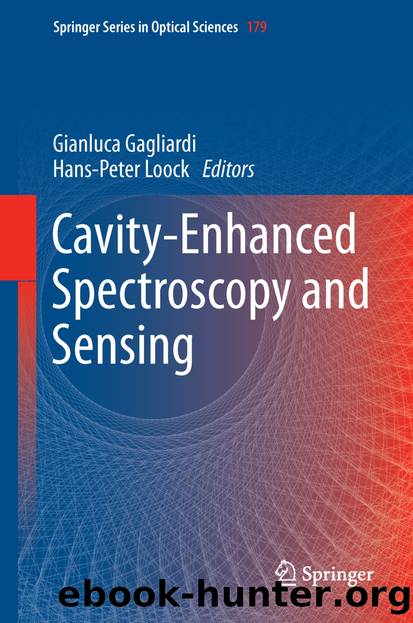Cavity-Enhanced Spectroscopy and Sensing by Gianluca Gagliardi & Hans-Peter Loock

Author:Gianluca Gagliardi & Hans-Peter Loock
Language: eng
Format: epub
Publisher: Springer Berlin Heidelberg, Berlin, Heidelberg
7.2.1 Near-Infrared
To date, the vast majority of NICE-OHMS experimental setups have worked in the near-IR spectral region. Near-infrared optical components are generally less expensive, more readily available, and have better performance than the corresponding components designed for the mid-infrared, in part due to the large amount of research and development invested in the field by the telecommunications industry. Component selection is particularly important when it comes to the optical components that need to work at radio frequencies of ≳100 MHz, namely a high-speed detector and a method of modulating the laser frequency for heterodyne spectroscopy. Dielectric coatings for cavity mirrors also tend to be better-developed and higher performing in the near-infrared than in the mid-infrared, with losses of up to an order of magnitude lower than the best mid-infrared coatings available.
One disadvantage of working in the near-IR is that no fundamental vibrational bands for molecules lie in this region, so NICE-OHMS spectrometers in this region need to observe overtones or combination bands, which tend to be much weaker than fundamental bands. Since NICE-OHMS is such a sensitive technique, these detections are still possible, but it makes the detection limit in terms of quantity of analyte required for detection significantly larger than it would be for a spectrometer of the same sensitivity observing fundamental band transitions.
Download
This site does not store any files on its server. We only index and link to content provided by other sites. Please contact the content providers to delete copyright contents if any and email us, we'll remove relevant links or contents immediately.
The Complete Stick Figure Physics Tutorials by Allen Sarah(7267)
Secrets of Antigravity Propulsion: Tesla, UFOs, and Classified Aerospace Technology by Ph.D. Paul A. Laviolette(5238)
Thing Explainer by Randall Munroe(3850)
The River of Consciousness by Oliver Sacks(3499)
The Order of Time by Carlo Rovelli(3098)
How To by Randall Munroe(2971)
A Brief History of Time by Stephen Hawking(2913)
I Live in the Future & Here's How It Works by Nick Bilton(2901)
The Great Unknown by Marcus du Sautoy(2616)
What If?: Serious Scientific Answers to Absurd Hypothetical Questions by Randall Munroe(2591)
Midnight in Chernobyl by Adam Higginbotham(2434)
Blockchain: Ultimate Step By Step Guide To Understanding Blockchain Technology, Bitcoin Creation, and the future of Money (Novice to Expert) by Keizer Söze(2411)
Networks: An Introduction by Newman Mark(2306)
The Meaning of it All by Richard Feynman(2269)
Easy Electronics by Charles Platt(2253)
The Tao of Physics by Fritjof Capra(2205)
Midnight in Chernobyl: The Untold Story of the World's Greatest Nuclear Disaster by Adam Higginbotham(2128)
When by Daniel H Pink(2058)
Introducing Relativity by Bruce Bassett(2050)
